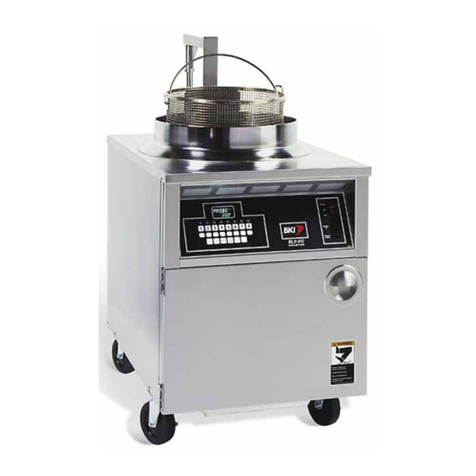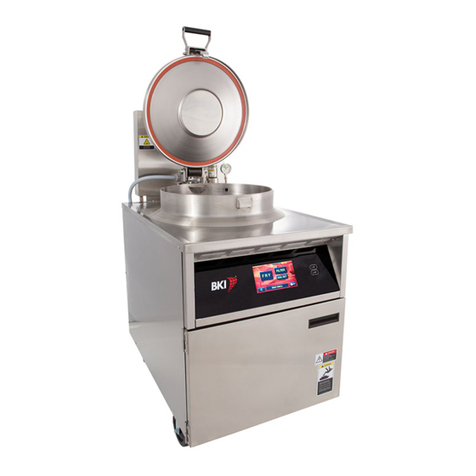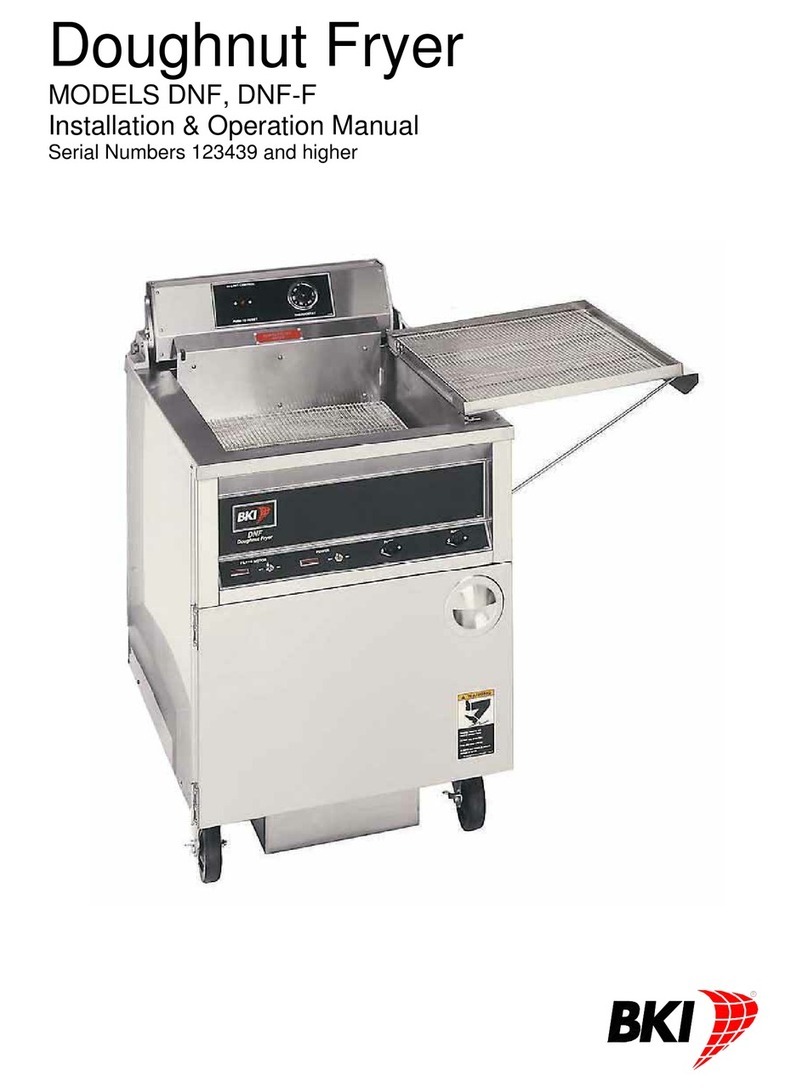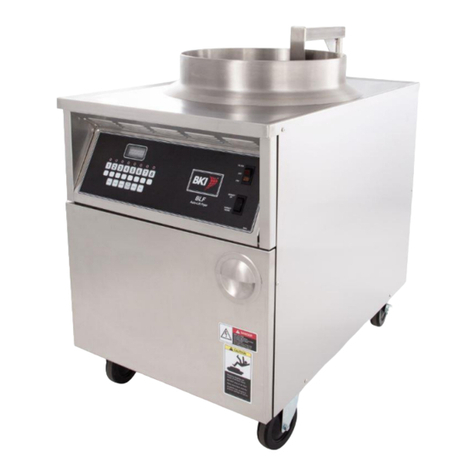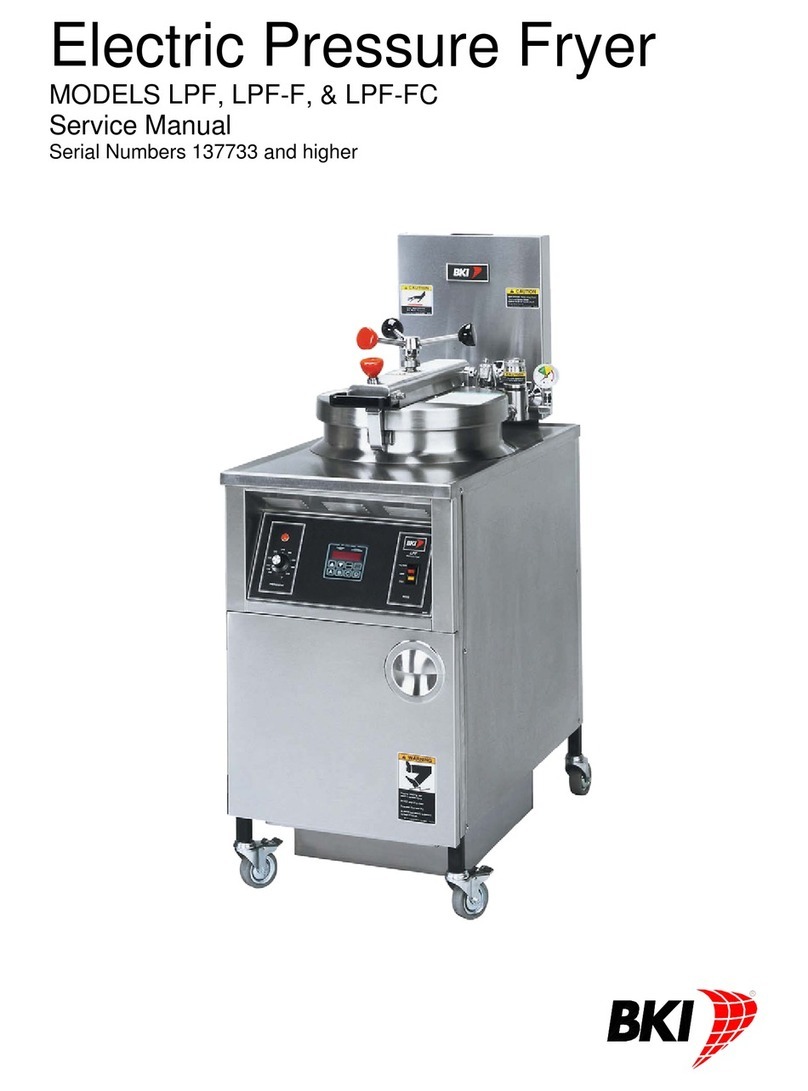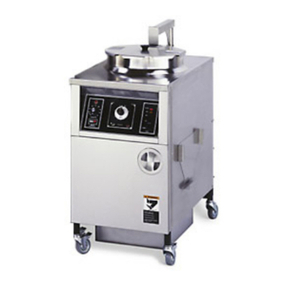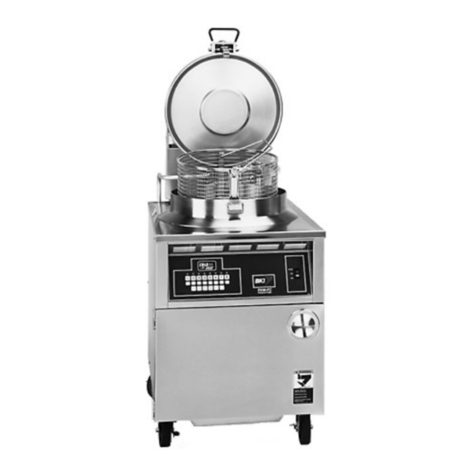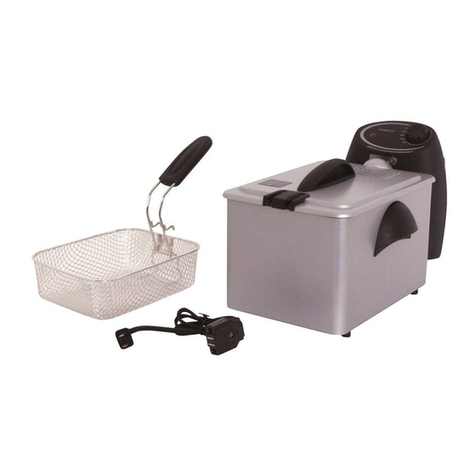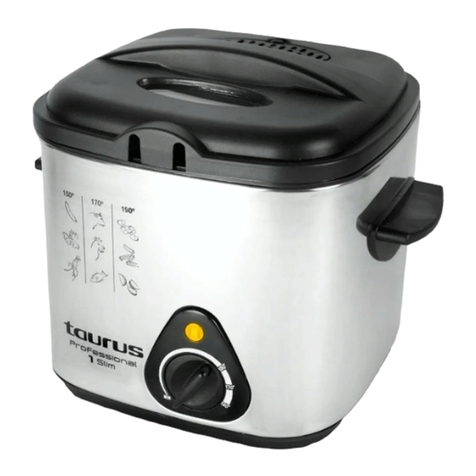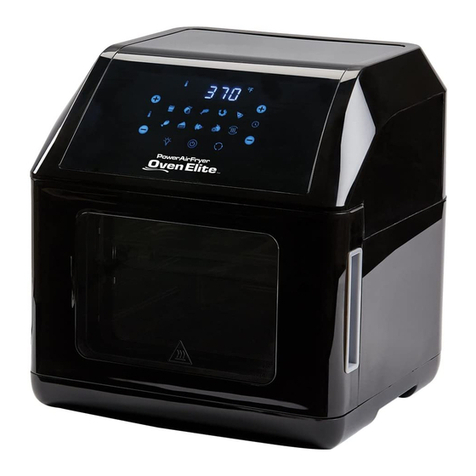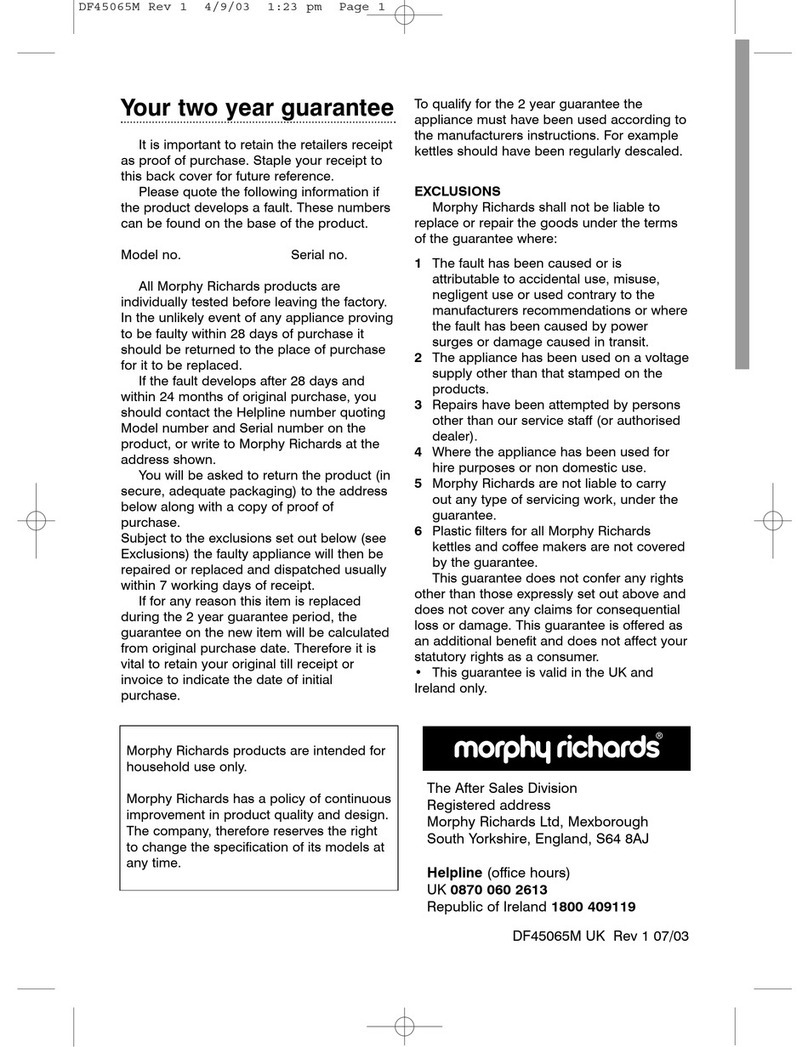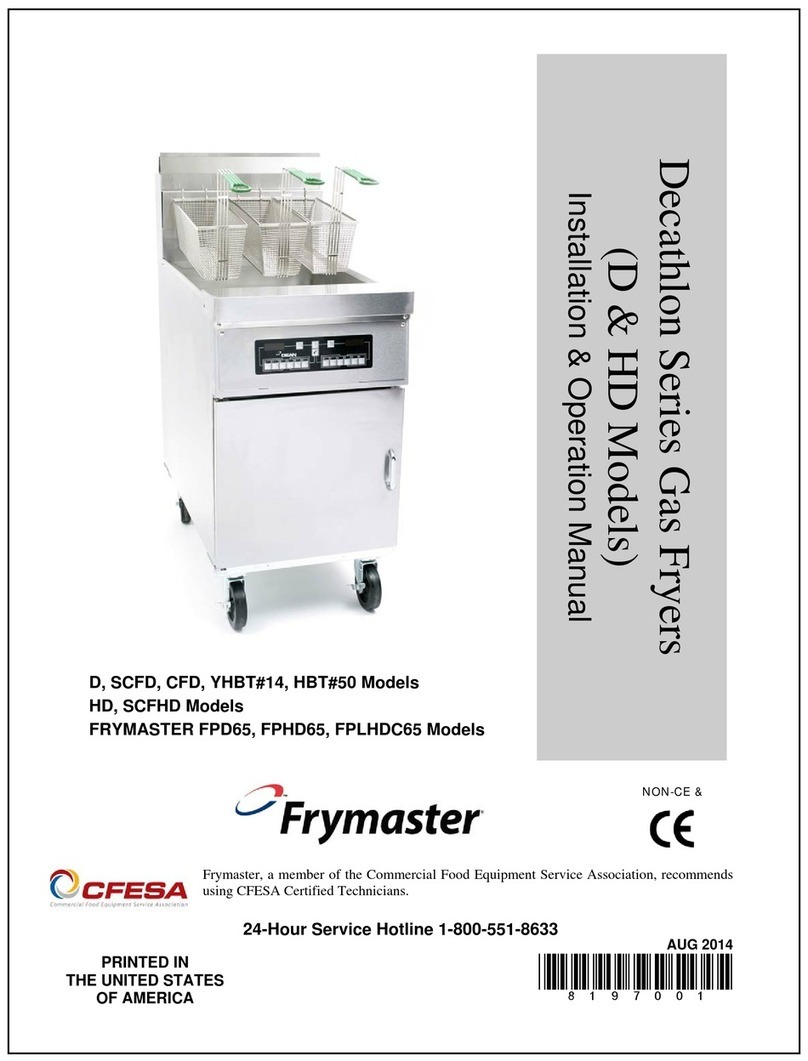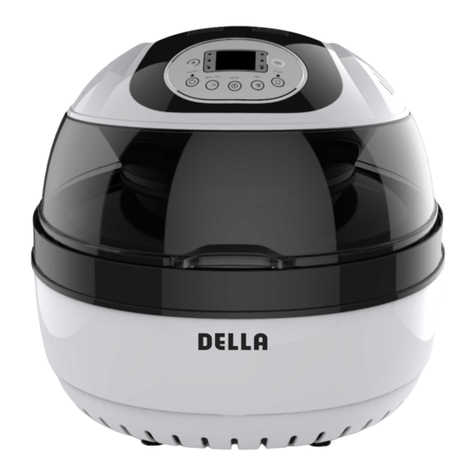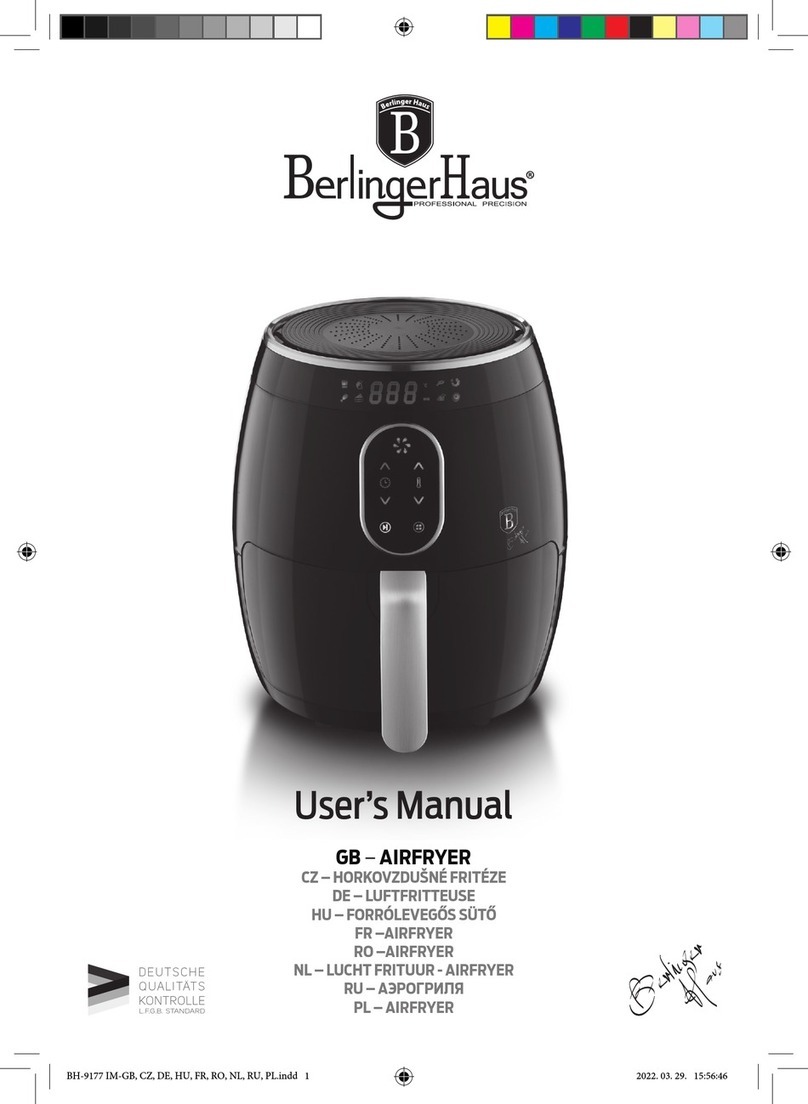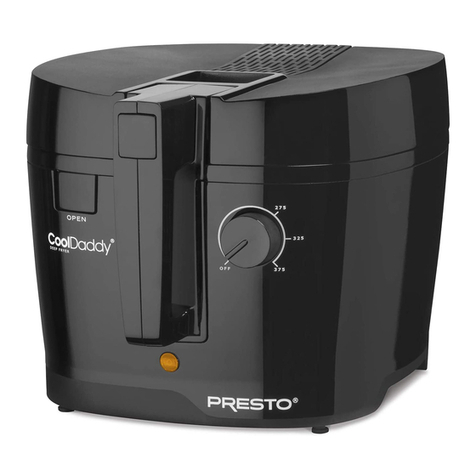BKI BLG User manual

SERIES: BLG-FC
Operation Manual
Extra-Large Gas
Auto-Lift Fryer

SS-OM-047 Revised 10/1/2013
BKI® IMITED WARRANTY
2812 Grandview Dr. • Simpsonville, SC 29680 • USA
(864 963-3471 • Toll Free: (800 927-6887 • Fax: (864 963-5316
WHAT IS
COVERED This warranty covers defects in material and workmanship under normal use, and applies
only to the original purchaser providing that:
អ
The equipment has not been accidentally or intentionally damaged, altered or misused;
អ
The equipment is properly installed, adjusted, operated and maintained in accordance
with national and local codes, and in accordance with the installation and operating
instructions provided with this product.
អ
The serial number rating plate affixed to the equipment has not been defaced or
removed.
WHO IS COVERED This
warranty
is
extended
to the original
purchaser
and applies only
to
equipment purchased
for use in the U.S.A.
COVERAGE PERIOD
អ
Warranty claims must be received in writing by BKI within one (1) year from
date of installation or within one (1) year and three (3) months from data of
shipment from the factory, whichever comes first.
អ
COB Models: One (1) Year limited parts and labor.
អ
COM Models: Two (2) Year limited parts and labor. COM convection ovens also have
a two (2) year door warranty.
អ
CO1 Models: Two (2) Year limited parts and labor. Five (5) Year limited door
warranty.
អ
Bev es Products: Two (2) Year limited parts and labor.
អ
Warranty period begins the date of dealer invoice to customer or ninety (90)
days after shipment date from BKI, whichever comes first.
WARRANTY COVERAGE This
warranty
covers on-site labor, parts and
reasonable
travel
time
and travel
e
xpenses
of the
authorized
service
representative
up
to
(100) miles
round
trip and
(2)
hours
travel time and
performed
during
regular,
weekday
business
hours.
EXCEPTIONS Any exceptions must be pre-approved in advance and in writing by BKI. The
extended door warranty on convection ovens years 3 through 5 is a parts only warranty
and does not include labor, travel, mileage or any other charges.
EXC USIONS
អ
Negligence
or acts of
God,
អ
Thermostat
calibrations
after (30) days
from
equipment
installation
date,
អ
Air and g
as
adjustments,
អ
ight
bulbs,
អ
Glass doors and
door
adjustments,
អ
Fuses,
អ
Adjustments
to
burner
flames and
cleaning
of
pilot
burners,
អ
Tightening
of screws
or
fasteners,
អ
Failures
caused
by erratic
voltages
or gas
suppliers,
អ
Unauthorized
repair by
anyone
other
than
a BKI F
actory
Authorized
Service Center,
អ
Damage
in
shipment,
អ
Alteration,
misuse or
improper
installation,
អ
Thermostats
and safety valves with
broken
capillary tubes,
អ
Freight
–
other
than
normal UPS charges,
អ
Ordinary
wear and
tear,
អ
Failure to follow
installation
and/or
operating
instructions,
អ
Events
beyond
control
of the
company.
INSTA ATION eveling, as well as
proper
installation
and check out of all
new
equipment
-
per
appropriate installation
and use materials – is t
he
responsibility of the
dealer
or
installer, not the
manufacturer.
REP ACEMENT PARTS
BKI
genuine
Factory OEM parts receive a (90) day
materials
warranty
effective from
the date of
installation
by a BKI F
actory
Authorized
Service
Center.

Gas Pressure Fryer Table of Contents
2
The purchaser must post, in a prominent location, instructions to be followed in the event the user smells
gas. This information shall be obtained by consulting the local gas supplier.
FOR YOUR SAFETY
Do not store or use gasoline or other flammable vapors or liquids in the vicinity of this or any
other appliance.
Improper installation, adjustment, alteration, service or maintenance can cause property damage,
injury or death. Read the installation, operation and maintenance instructions thoroughly before
installing or servicing this equipment.

Gas Pressure Fryer Table of Contents
1
Table of Contents
Table of Contents..................................................................................................................................................... 1
Introduction .............................................................................................................................................................. 2
Safety..................................................................................................................................................................... 2
Safety Signs and Messages.............................................................................................................................. 2
Specific Precautions.......................................................................................................................................... 3
Equipotential ground plane ........................................................................................................................... 3
Full Disconnection......................................................................................................................................... 3
Safe Work Practices.......................................................................................................................................... 4
Safety abels..................................................................................................................................................... 8
Installation ................................................................................................................................................................ 9
Inspection for Shipping Damage ........................................................................................................................... 9
Preparation ............................................................................................................................................................ 9
ocation and Clearance......................................................................................................................................... 9
Installation Procedure .......................................................................................................................................... 10
Initial Test and Adjustment .................................................................................................................................. 11
Operation ................................................................................................................................................................ 12
Controls and Indicators........................................................................................................................................ 12
Care of the Shortening ........................................................................................................................................ 15
B G and B G-F Operation .................................................................................................................................. 16
Start-Up (B G and B G-F).............................................................................................................................. 16
Cooking (B G and B G-F) .............................................................................................................................. 17
B G-FC Operation............................................................................................................................................... 18
System Programming...................................................................................................................................... 18
Product Programming ..................................................................................................................................... 20
Start-Up (B G-FC) .......................................................................................................................................... 23
Cooking (B G-FC)........................................................................................................................................... 23
Operation After Gas or Power Outage ................................................................................................................ 24
Normal Shutoff..................................................................................................................................................... 24
Maintenance ........................................................................................................................................................... 25
Scheduled Maintenance ...................................................................................................................................... 25
Filter Pad Replacement................................................................................................................................... 28
Troubleshooting ................................................................................................................................................... 29

Gas Pressure Fryer Introduction
2
Introduction
The B G Fryer is compact, attractive and functional in design. It is constructed of a stainless steel fryer pot for
cleaning ease. Exclusive BKI patented features and safety devices offer flexibility, efficiency and reliability plus
PERFECTION IN PRESSURE FRYING!
The BKI name and trademark on this unit assures you of the finest in design and engineering -- that it has been
built with care and dedication -- using the best materials available. Attention to the operating instructions
regarding proper installation, operation, and maintenance will result in long lasting dependability to insure the
highest profitable return on your investment.
P EASE READ THIS ENTIRE MANUA BEFORE OPERATING THE UNIT. If you have
any questions, please contact your BKI Distributor. If they are unable to answer your
questions, contact the BKI Technical Service Department, toll free: 1-800-927-6887.
Outside the U.S., call 1-864-963-3471.
Safety
Always follow recommended safety precautions listed in this manual. Below is the safety alert symbol. When you
see this symbol on your equipment, be alert to the potential for personal injury or property damage.
Safety Signs and Messages
The following Safety signs and messages are placed in this manual to provide instructions and identify specific
areas where potential hazards exist and special precautions should be taken. Know and understand the meaning
of these instructions, signs, and messages. Damage to the equipment, death or serious injury to you or other
persons may result if these messages are not followed.
This message indicates an imminently hazardous situation which, if not avoided, will
result in death or serious injury.
This message indicates a potentially hazardous situation, which, if not avoided, could
result in death or serious injury.
This message indicates a potentially hazardous situation, which, if not avoided, may
result in minor or moderate injury. It may also be used to alert against unsafe practices.
This message is used when special information, instructions or identification are required
relating to procedures, equipment, tools, capacities and other special data.

Gas Pressure Fryer Introduction
3
Specific Precautions
Risk of fire exists if the oil level drops below 5mm of the maximum oil level.
Use of oil/shortening older than the manufacturer’s recommendations for life of
the oil is prone to surge boiling and flash fires. Follow the oil manufacturer’s
guidelines for the life cycle of oil/shortening.
Do not open the drain valve or the fill valve while the fryer is in operation.
Serious burns may result.
Follow instructions regarding effects of surge boiling of over-wet foods and
proper load size.
Equipotential ground plane
When a high current flows through a conductor, differences in potential appear
between the conductor and nearby metallic surfaces near the appliance. As a
result, sparks may be produced between the appliance and surrounding metal
surfaces. These sparks could cause serious injury, damage, or fire.
BKI provides an Equipotential ground terminal for the connection of a bonding
conductor after the installation of the appliance per lEC60417-1. This terminal is
located on the inside of the Power Entry Supply box near the Earth connection
and is marked with this symbol.
Full Disconnection
In accordance with ocal and/or National wiring codes, the installer must provide
a means of full disconnection under over voltage Category III conditions. An IEC
approved cord and plug combination will meet this requirement.
Units not provided with a cord and plug do not meet this requirement. In
accordance with ocal and/or National wiring codes, the installer must provide
the means of full disconnection.
The fryer is designed to hold a maximum of 75lbs (34KG) of oil/shortening.
The appliance and its individual shutoff valve must be disconnected from the gas
supply system during any pressure testing of that system at test pressures in
excess of ½ psi (3.5 kPa).

Gas Pressure Fryer Introduction
4
Safe Work Practices
Do Not Store Or Use Anything Flammable Near
The Fryer
Your pressure fryer is powered by either natural gas. Do not store or use
gasoline or any flammable liquids or vapors near this or any other
appliance. Flammable materials will burn easily. etting any flammable
liquid or vapor get too close to the fryer could cause an explosion or fire.
Serious injury could result. Examples of flammables that you should not
store near the fryer are gasoline, paint, thinners or removers, gas tanks,
and cleaning materials.
Use Gas Safely-- Avoid Danger
Gas can be a dangerous fuel if not handled safely.
Make sure to ventilate the fryer properly. If the fryer is not properly
ventilated, carbon monoxide can be released around the fryer.
Asphyxiation or suffocation can occur if gas is not ventilated properly.
Before using this appliance for the first time, contact your local gas supplier
for instructions about what to do if you smell gas. Post those instructions
somewhere near the fryer, so that everyone who uses or works near the
fryer knows what to do if they smell gas.
Beware of High Voltage
This equipment uses high voltage. Serious injury can occur if you or any
untrained or unauthorized person installs, services, or repairs this
equipment. Always Use an Authorized Service agent to Service Your
Equipment.
Use the Fryer on Noncombustible Floors Only
Make sure your floor is noncombustible. Do not operate your fryer on floors
that are wood, carpeted or have rubber mats. Placing your fryer on a
combustible floor could cause a fire. Serious injury could result. Examples
of noncombustible floors where you can safely place your fryer are
concrete, tile, and ceramic.
Keep the Area Around Your Fryer Uncluttered
Make sure to keep the area around your fryer clear of any obstacles.
Serious injury can occur if you trip or fall near the fryer. You could be
burned by hot shortening that splashes out of the fryer or by falling against
the hot metal of the fryer.

Gas Pressure Fryer Introduction
5
Keep the Floor Around Your Fryer Clean Of
Shortening
Make sure to keep the floor around your fryer clean of shortening and
other liquids. Serious injury can occur if you slip near your fryer. You could
be burned by hot shortening that splashes out of the fryer or by falling
against the hot metal of the fryer.
Keep the Casters Locked
To avoid spilling shortening, keep the casters locked. If any shortening
spills near your fryer, clean it up immediately.
Do Not Overfill the Fryer with Shortening
Hot shortening and steam may escape and burn you if you put too much
shortening in the fryer. Fill the fryer to approximately one inch below the fill
marks that are inside the fryer pot. Heat the shortening. If needed, carefully
add more shortening to bring the level to the fill marks.
Do Not Let Any Water Get into The Fryer
Always remove excess moisture from food before placing it into the fryer
basket. Water will cause the hot shortening to spatter. You could be
burned.
Do Not Overload the Basket With Food
Hot shortening and steam may escape and burn you if you place too much
food in the basket.
Wear Safe Clothing Appropriate To Your Job
Always wear your insulated mitts when handling the fryer basket or touch
any hot metal surfaces. You received a pair of insulated mitts with your
fryer. If you lose or damage your mitts, you can buy new ones at your local
restaurant equipment supply store or from your local BKI Distributor.
Always wear non-skid shoes when working around the fryer or any other
equipment that uses shortening. Never wear loose clothing such as
neckties or scarves while operating your fryer. Keep loose hair tied back or

Gas Pressure Fryer Introduction
6
in a hair net while operating your fryer.
Always wear appropriate personal protection equipment during the filtering
process to guard against possible injury from hot oil.
Always wear appropriate personal protection equipment during the boil-out
process to guard against possible injury from hot cleaning solution.
Keep Away From the Vent
Hot steam escapes from the vent continuously when you are using your
fryer. You could be burned if you get too close to the vent.
Keep this manual with the Equipment
This manual is an important part of your equipment. Always keep it near
for easy access.
If you need to replace this manual, contact:
BKI
Technical Services Department
2812 Grandview Drive
Simpsonville, S.C. 29680
Or call toll free: 1-800-927-6887
Outside the U.S., call 864-963-3471
Protect Children
Keep children away from this equipment. Children may not understand that
this equipment is dangerous for them and others.
NEVER allow children to play near or operate your equipment.
Keep Safety Labels Clean and in Good Condition
Do not remove or cover any safety labels on your equipment. Keep all
safety labels clean and in good condition. Replace any damaged or
missing safety labels. Refer to the Safety abels section for illustration and
location of safety labels on this unit.
If you need a new safety label, obtain the number of the specific label
illustrated on page 8, then contact:
BKI
Technical Services Department
2812 Grandview Drive
Simpsonville, S.C. 29680
Or call toll free: 1-800-927-6887
Outside the U.S., call 864-963-3471

Gas Pressure Fryer Introduction
7
Be Prepared for Emergencies
Be prepared for fires, injuries, or other emergencies.
Keep a first aid kit and a fire extinguisher near the equipment. You must
use a 40-pound Type BC fire extinguisher and keep it within 25 feet of your
equipment.
Keep emergency numbers for doctors, ambulance services, hospitals, and
the fire department near your telephone.
Know your responsibilities as an Employer
• Make certain your employees know how to operate the equipment.
• Make certain your employees are aware of the safety precautions on
the equipment and in this manual.
• Make certain that you have thoroughly trained your employees about
operating the equipment safely.
• Make certain the equipment is in proper working condition. If you make
unauthorized modifications to the equipment, you will reduce the
function and safety of the equipment.
Do Not Smoke Near The Fryer.
Electrical Grounding Instructions:
This appliance is equipped with a three-prong (grounding) plug for your
protection against shock hazard and should be plugged directly into a
properly grounded three-prong receptacle. Do not cut or remove the
grounding prong from this plug.

Gas Pressure Fryer Introduction
8
Safety Labels

Gas Pressure Fryer Installation
9
Installation
Inspection for Shipping Damage
It is the owners’ responsibility to file all freight claims with the delivering truck line. Inspect all cartons and crates
for damage as soon as they arrive. If damage to cartons or crates is found, or if a shortage is found, note this on
the bill of lading (all copies) prior to signing.
If damage is found when the equipment is opened, immediately call the delivering truck line and follow up the call
with a written report indicating concealed damage to your shipment. Ask for an immediate inspection of your
concealed damage item. Packaging material MUST be retained to show the inspector from the truck line.
Preparation
There are several things the installer must know before installing the fryer. These are listed below:
• The fryer installation must conform with city or county standards for gas appliances and gas piping. If your
area does not have local codes, consult the National Fuel Gas Code, ANSI Z223.1/NFPA 54, or the
Natural Gas and Propane Installation Code, CSA B14 .1. In Europe, city and country codes are enforced.
• The fryer must be electrically grounded to conform with the local code of your city or county. If your area
does not have local codes, consult the latest version of the National Electrical Code ANSI/NFPA 70, or
the Canadian Electrical Code, CSA C22.2. In EUROPE, city and country codes are enforced.
• A schematic diagram of the unit is glued to the back of either the left or right side panel.
• The Authorized Service Agent that installs your fryer must connect the cord set at the rear of the fryer to
an electrical source with a voltage matching that stamped on the name and rating tag. Refer to the wiring
diagrams in this manual.
• Make sure a connector is used that complies with the Standard for Connectors for Movable Gas
Appliances, ANSI Z21.6 • CSA 6.16.
• Make sure a quick-disconnect device is used that complies with the Standard for Quick-Disconnect
Devices for Use With Gas Fuel, ANSI Z21.41 • CSA 6. .
• In Europe, the installer must supply the gas supply connector.
• Make sure a restraining device is used that complies with the Standard for Commercial Gas Ranges,
ANSI Z83.11/CGA 1.8 (such as BKI part number FT0279) to guard against transmission of strain to the
connector.
• Retain the manual for future reference.
Location and Clearance
Install your fryer in a well-ventilated area. This will ensure that the gas burns properly and will help prevent any
fires. When deciding on a location for your fryer, remember the following:
• All gas-burning appliances need enough fresh air for combustion.
• ocate the fryer where it can be vented into an adequate exhaust hood. Your local gas utility must
approve your ventilation system. Consult a ventilation or heating company to help you design an
adequate system that meets ventilation codes and standards for your city or county. In Europe, install
according to local codes.
• Keep the fryer away from any combustibles such as curtains, wood paneling, boxes, or towels. The flue
riser at the rear of the fryer should also be kept away from any flammable material.

Gas Pressure Fryer Installation
10
• Use this fryer on non-combustible flooring only. Examples of non-combustible floors where you can safely
locate your fryer are concrete, tile, and ceramic. Minimum clearance from combustible and non-
combustible construction is 0 inches from the sides and 6 inches from the flue riser at the rear. DO NOT
locate your fryer on floors that are wood, have rubber mats, or, are carpeted. In Europe, no less than 6"
(15.24 cm.) from the rear and 0" to the sides of non-combustible walls.
• Keep the work area around the fryer free of objects that might block fresh air or that might cause a fire.
• Do not attach an extension to the exhaust stack. This may stop the burner from operating properly, cause
the burner to go off, or, cause other dangerous malfunctions. It may also cause a strong draft in the room.
A draft can interfere with the burner.
• Do not locate the fryer near strong drafts. Keep the fryer away from doors that are opened and closed
frequently.
Installation Procedure
Ensure that an authorized BKI service agent installs the fryer. An authorized BKI service
agent should be a qualified gas service technician and a licensed electrician.
Failure to restrain the fryer could allow it to move, causing hot shortening to spill out, or a
possible break in the gas line causing an explosive condition.
1. Install an ANSI Z83.11/CGA 1.8 compliant restraining device (such as BKI part number FT0279) per the
instructions below:
• Mount the wall attachment according to the restraining device manufacturer instructions.
• Attach the spring-loaded hook on the restraining device to the eye-bolt mounted to the fryer then
attach the other spring-loaded hook to the wall attachment.
Use appliance connectors and quick-disconnect devices that are in compliance with the
applicable ANSI and CSA standards.
2. Attach an appliance connector to the fryer according to the instructions provided by the appliance
connector manufacturer.
3. Connect the gas supply to the fryer. In Europe, the gas supplier must provide the gas hookup connecting
line.
4. ock the casters so the fryer does not move. Every time you use the fryer, make sure the casters are
locked so the fryer cannot move. (In Canada: refer to caster codes CAN 1-6.10 M88 and CAN 1-6.9
M79.)

Gas Pressure Fryer Installation
11
5. Turn on the gas at the gas supply valve.
6. Check for gas leaks from the gas supply to the fryer gas valve using a soap and water solution. If a leak is
detected, tighten the connection where the leak occurs.
7. Connect fryer wiring according to the appropriate wiring diagram in this manual.
8. Apply power to the fryer.
9. Perform the following procedures provided in the Startup and Checkout section of the
SV9401/SV9402/SV9403, SV9501/SV9502/SV9503, SV9601/SV9602 SmartValve™ SYSTEM
CONTRO S Installation Instructions (69-1004-2). Refer to Error! Reference source not found..
• Gas eak Test
• Check and Adjust Gas Input Burner Ignition
Initial Test and djustment
1. Open the gas supply valve.
2. Place the DRAIN handle in the C OSED position.
3. Fill pot with shortening to the fill mark.
Risk of fire exists if the oil level drops below the minimum oil level. The level of oil
within the pot must not fall below 5mm of the maximum oil level.
Use of oil/shortening older than the manufacturer’s recommendations for life of
the oil is prone to surge boiling and flash fires. Follow the oil manufacturer’s
guidelines for lifecycle of oil/shortening.
Overfilling the fryer pot with shortening could lead to serious injury. Ensure that
the fryer pot is filled with shortening only to the fill mark when shortening is hot.
Do not use any shortening other than what is specified in this manual and do not
overfill the fryer pot.
The fryer has a maximum temperature setting of 375º F/190º C (for B G and
B G-F) or 390º F/200º C (for B G-FC). Do not use oil/shortening with a
flashpoint less than 554º F (290º C)
Use only high-quality shortening that has low moisture content, a high smoke
point and no additives.
4. Place the gas control ON/OFF switch in the OFF position.
5. Place the FILTER/OFF/FRY switch in the OFF position.
6. Before you turn on the gas, wait at least five minutes to allow any gas that may have accumulated in the
burner compartment to escape.
7. Place the gas control ON/OFF switch in the ON position.
8. Place the FILTER/OFF/FRY switch to the FRY position. The shortening should begin to heat and begin to
reach the fill mark inside the pot. Add more shortening as required to reach the fill mark.

Gas Pressure Fryer Operation
12
Operation
Controls and Indicators
Refer to the figure and table below for an explanation of the fryer’s controls and indicators.

Gas Pressure Fryer Operation
13
Item Description Function
1 Computer Used to program the cooking computer and activate the programs
2 Momentary Switch BASKET UP – Momentarily pushing the switch to this position causes the
lift mechanism to rise. This is enabled only when the FI TER/OFF/FRY
switch is in the FRY position.
BASKET DOWN – Momentarily pushing the switch to this position causes
the lift mechanism to lower. This is enabled only when the
FI TER/OFF/FRY switch is in the FRY position.
3 Rocker Switch FI TER – When placed in this position, power is applied to the motor and
shortening is pumped into the pot directly or through the fill hose.
OFF – When placed in this position, power is removed from the pump
motor, heating elements and lift mechanism.
FRY – When placed in this position, power is supplied to the thermostat (or
computer), heating elements and lift mechanism.
4 Thermostat Knob Used to set the temperature of the shortening.
5 Thermostat ight Illuminates to indicate that the elements have power applied to them.
6 Digital Timer The digital timer consists of an ED, display, beeper and 8 buttons
described below:
ED indicator Prior to the start of a timing cycle the ED will be OFF. When running a
timing cycle the ED will flash. At the end of a timing cycle the ED will
turn ON steady. When idle the ED is off.
TIME SE ECT (2
arrow buttons)
Two arrow buttons on the front panel are used to set the time. Hold the UP
ARROW button down to increase the time. The longer the button is held
down, the faster the rate at which the time will increase. The DOWN
ARROW button is used in the same manner as the UP ARROW button
except it will cause the time to decrease. The time is increased or
decreased in 30-second increments.
START/STOP button Starting the Timer - Pressing this button while the timer is not active will
cause the timer to begin counting down the time on the display.
Stopping the Timer - Pressing this button while the timer is active will
stop the timer from counting down and display the remaining time. Time
cannot be changed with the TIME SE ECT buttons at this point. If this
button is pressed again the timer will continue counting down from the
point it was stopped.
Resetting the Timer - Pressing and holding this button for longer than two
(2) seconds will reset the timer and the display will return to the original
starting time. At this point, time can be changed using the TIME SE ECT
buttons or the preset buttons.
Canceling The STIR OIL Function - Pressing this button cancels the
STIR OI function while it is active.
A ARM button This button allows the user to set an elapsed time at which the internal
alarm will sound during a cycle. The time is set by pressing and holding
the A ARM button while using the UP and DOWN arrows to change the
time. The controller will limit the alarm time to be less than the currently
programmed interval cycle time. The default alarm time is 0:00 which
disables it. The A ARM time is saved on power down in the same manner
as the last interval time. When a time cycle is running and the alarm time
has elapsed the internal alarm will sound for 10 seconds. For example, a
cycle time 10:00 and alarm time of 2:00 would cause the alarm to sound
for 10 seconds once the controller has counted down from 10:00 to 8:00.
This button is also used to cancel the STIR OI function.

Gas Pressure Fryer Operation
14
Item Description Function
6 A, B, C, D preset
buttons
These buttons are used to save and recall preset cycle and alarm times,
saving operator time and minimizing error when changing interval cycle
times and alarm times. To save the current interval and alarm times into
one of the preset locations, press and hold the A, B, C, or D preset button
for 2 seconds and the controller will double chirp to indicate the times have
been saved. To recall any preset time, press and quickly release the
appropriate button and the time values are loaded and displayed.
Beeper A beeper sounds when the timer counts down to 0. Pressing the
START/STOP button stops the beeper and resets the timer causing the
display to return to the original starting time. At this point, time can be
changed using the TIME SE ECT buttons or the preset buttons. The
beeper will also sound for 10 seconds if the alarm time has elapsed during
a timing cycle. When the STIR OI function begins the beeper will sound
until the A ARM or START/STOP button is pressed.
Display Used to display the time. It also displays the words “STIR” then “OI ” in .5
second intervals until the A ARM or START/STOP button is pressed.
7 High imit Reset Switch ocated under the control panel. If the heating elements inside the pot
reach an unsafe temperature, power is automatically removed from the
control panel, lift mechanism and elements. Pressing this switch returns
power to the control panel, left mechanism and elements.
8 Drain ever DRAIN OPEN – When placed in this position, the drain valve opens and
shortening drains into the vat. Also power is removed from the control
panel and gas system.
DRAIN C OSED – When placed in this position, the drain valve is closed
to prevent shortening from draining into the pot. Also power is restored to
the control panel and gas system.
9 Fill ever FI THRU POT – When placed in this position, shortening will be pumped
from the vat to the pot if the rocker switch is in the FI TER position.
FI THRU HOSE – When placed in this position, shortening will be
pumped from the vat to the pot via a fill hose if the rocker switch is in the
FI TER position.
10 Rinse Hose Connector Used to connect the Rinse hose for cleaning and refilling the pot.
11 Pump Motor Reset Switch If the motor overheats while filtering, it will automatically shut off. Wait 15
minutes to allow motor to cool before pressing this switch.
12 Ignition ock-out ight Illuminates when the Ignition Module locks out during ignition.
13 Reset Switch Used to reset the Ignition Module when it locks out during ignition.

Gas Pressure Fryer Operation
15
Care of the Shortening
Solid shortening should always be returned to the filter vat while in the liquid state. If this is not done, it will have
to be heated to a liquid state. When using solid shortening, the fryer must be equipped with a pump heater. After
filtering with solid shortening, the filter lines must be completely emptied of shortening. The pump heater will take
care of any residual shortening in the pump, but cannot melt all of the shortening in the filter lines. The pump
heater accessory may be purchased separately from BKI.
To extend the life of your shortening, for the best possible flavor in your products, and for economy and efficiency
of operation, we urge you to follow these recommendations:
1. Use only high-quality frying shortening without additives, of low moisture content and with a high smoke
point.
2. Press excess moisture from products before breading. The more moisture released in the shortening, the
quicker it will break down.
3. Filter at least once a day or once every three loads during frequent cooking.
4. Clean any residue or crust formations from the sides and bottom of the pot each time you filter the
shortening.
5. Add fresh shortening as needed to maintain the proper shortening level TO THE FILL M RK ON THE
POT W LL.
6. DO NOT HOLD SHORTENING T HIGH TEMPER TURE when the fryer is not in use. If you expect an
elapsed time of one hour or more between cooking, close the lid and press the “0” button on the B G-FC
model. On Models B G and B G-F, set the thermostat to 150º F.
7. Shortening changes are determined by the quantity and type of food prepared. Excessive boiling and
foaming are definite signs of shortening breakdown.
8. After you have finished frying for the day, filter the shortening and replace the filter pad. Also, thoroughly
clean the pot of sediment and crumbs and empty the condensate pan.
9. IMPORTANT! Before the first cooking operation each day, stir the shortening freely while it is heating to
provide a balanced shortening temperature for excellent results with the first cooking. Failure to do this
can result in a crusty skin on the product surface with an undercooked product internally. In addition, in
some cases, failure to stir the shortening while it is initially heating may cause the HI- IMIT safety to
disable the power due to a false overshoot condition.

Gas Pressure Fryer Operation
16
BLG and BLG-F Operation
Start-Up (BLG and BLG-F
1. Make sure the main drain valve is closed.
2. Fill pot with shortening to the fill mark.
Risk of fire exists if the oil level drops below the minimum oil level. The level of oil
within the pot must not fall below 5mm of the maximum oil level.
Use of oil/shortening older than the manufacturers recommendations for life of
the oil is prone to surge boiling and flash fires. Follow the oil manufacturers
guidelines for lifecycle of oil/shortening.
Overfilling the fryer pot with shortening could lead to serious injury. Ensure that
the fryer pot is filled with shortening only to the fill mark when shortening is hot.
Do not use any shortening other than what is specified in this manual and do not
overfill the fryer pot.
The B G/B G-F fryer has a maximum temperature setting of 375º F (190º C). Do
not use oil/shortening with a flashpoint less than 554º F (290º C)
Use only high-quality shortening that has low moisture content, a high smoke
point and no additives.
3. Place the gas control ON/OFF switch in the ON position.
4. Once the fryer is filled with shortening, place the FILTER/OFF/FRY switch in the FRY position. Unless the
STIR OI function is operating in the –OFF mode, the digital timer activates a STIR OI function and
begins an internal six minute countdown (not displayed). At the end of the internal countdown, the display
shows the words “STIR” then “OI ” in .5 second intervals and the alarm sounds. Depress the ALARM
button and stir the shortening freely while it is heating.
IMPORTANT! Before the first cooking operation each day, stir the shortening freely while it is heating to
provide a balanced shortening temperature for excellent results with the first cooking. Failure to do this
can result in a crusty skin on the product surface with an undercooked product internally. In addition, in
some cases, failure to stir the shortening while it is initially heating may cause the HI- IMIT safety device
to disable the power due to a false overtemperature condition.
5. Set the thermostat to the desired cook temperature. The temperature light will go on. When the
temperature is reached, the light will go off. The light will continue to cycle on and off as the fryer
maintains the set temperature.
6. Press and hold the TIME SELECT arrow buttons on the digital timer until the desired cook time is
displayed or recall a preset time by quickly pressing the appropriate preset button.
7. The shortening will heat and begin to reach the fill mark inside the pot. Add more shortening as required
to reach the fill mark.

Gas Pressure Fryer Operation
17
Cooking (BLG and BLG-F
Do not open the drain valve or the fill valve while the fryer is under pressure.
Serious burns may result.
1. Ensure that the Start-Up procedures have been performed.
2. When frying chicken, lower the basket into the shortening by depressing the basket switch to the
BASKET DOWN position.
Hot shortening may splash out of the pot causing severe injury when dropping chicken
into pot. Carefully drop pieces of chicken into pot to prevent shortening splashes.
3. Carefully drop the chicken in the shortening one piece at a time starting with breasts and thighs. The fryer
is designed to accommodate 48 pieces of chicken.
Failure to use the insulated mitts will result in severe injury. Always use the insulated
mitts when handling the hot fry basket.
4. Activate the timer by pressing the START/STOP button on the digital timer or press the recipe button
desired on the computer control. The control will begin to count down.
Hot shortening may splash out of the pot causing severe injury when lowering basket into
pot. Carefully lower basket into pot to prevent shortening splashes.
5. At the end of the frying cycle, the digital timer (or computer) beeper will sound and the basket will
automatically rise to its top position. Press the START/STOP button on the digital timer or press the
recipe button on the computer.
6. Allow the basket to drain.
Failure to use the insulated mitts will result in injury. Always use the insulated mitts when
handling the hot fry basket.
7. Remove basket from the lift and empty carefully.
8. Return the basket to the lift.
9. Remember to filter the shortening at least every third frying cycle load. Refer to the procedure in this
manual. Also filter the shortening and clean the fryer at the end of each day. If you do not plan to use the
fryer for an hour or more, turn the thermostat down to 150° F and close the lid.
10. When you have finished frying for the day, turn the FILTER/OFF/FRY switch to the OFF position.
This manual suits for next models
2
Table of contents
Other BKI Fryer manuals
Popular Fryer manuals by other brands
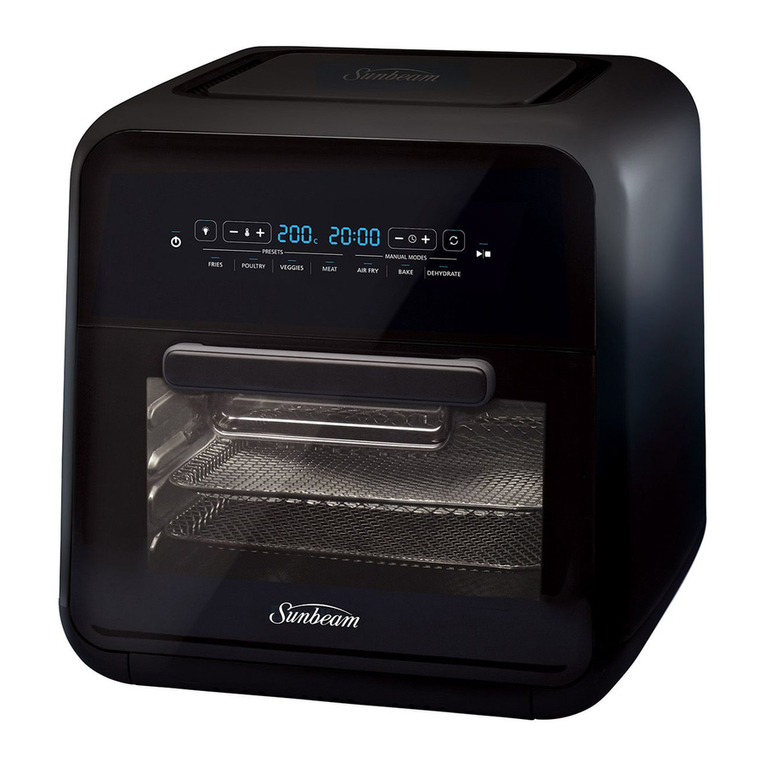
Sunbeam
Sunbeam AFP5000 user manual

T-Fal
T-Fal ACTIFRY user manual

Superior
Superior 515EDS Series Installation & operation instructions

Montgomery Ward
Montgomery Ward Chef Tested AF-605 instruction manual
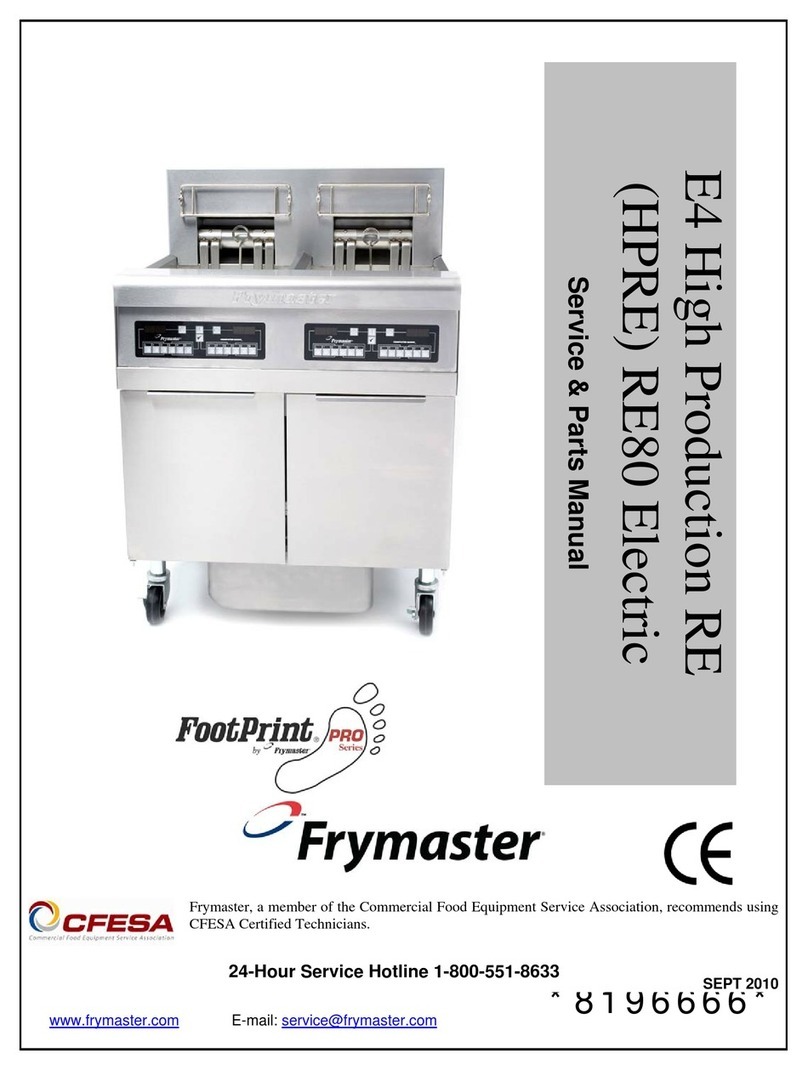
Frymaster
Frymaster FOOTPRINT RE80 Series Service & parts manual

GoWISE USA
GoWISE USA GW22632 instruction manual
